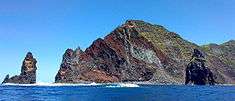Rosais
| Rosais | ||
| Civil Parish | ||
| Interior vista towards the northwestern coast and plateau of Rosais | ||
|
||
| Official name: Freguesia dos Rosais | ||
| Country | ||
|---|---|---|
| Autonomous Region | ||
| Island | São Jorge | |
| Municipality | Velas | |
| Localities | Arrifana, Canada da Trás, Canada das Faias, Fajã do João Dias, Quarteiro, Rosais | |
| Center | Rosais | |
| - elevation | 244 m (801 ft) | |
| - coordinates | 38°43′3″N 28°15′0″W / 38.71750°N 28.25000°WCoordinates: 38°43′3″N 28°15′0″W / 38.71750°N 28.25000°W | |
| Highest point | Monte Trigo | |
| - elevation | 504 m (1,654 ft) | |
| - coordinates | 38°44′33″N 28°17′27″W / 38.74250°N 28.29083°W | |
| Lowest point | Sea level | |
| - location | Atlantic Ocean | |
| - elevation | 0 m (0 ft) | |
| Area | 24.23 km2 (9 sq mi) | |
| - urban | .77 km2 (0 sq mi) | |
| Population | 743 (2011) | |
| Density | 31/km2 (80/sq mi) | |
| Settlement | c. 1568 | |
| LAU | Junta Freguesia | |
| - location | Ribeira D'Agua | |
| - coordinates | 38°43′2″N 28°15′3″W / 38.71722°N 28.25083°W | |
| President Junta | André Filipe Galego Ataíde (CDS-PP) | |
| President Assembleia | Gil António Bettencourt de Ávila (CDS-PP) | |
| Timezone | Azores (UTC-1) | |
| - summer (DST) | Azores (UTC0) | |
| Postal Zone | 9800-209 | |
| Area Code & Prefix | (+351) 292 XX XX XX | |
| Patron Saint | Nossa Senhora do Rosário | |
| Wikimedia Commons: Rosais (Velas) | ||
| Geographic detail from CAOP (2010)[1] produced by Instituto Geográfico Português (IGP) | ||
Rosais is a civil parish in the municipality of Velas in the Portuguese archipelago of the Azores. The population in 2011 was 743,[2] in an area of 24.23 km².[3]
History
Rosais already existed as a parish since 1568, when the first documents started appearing. It was considered the barn for the island of São Jorge, due to its great fertility and, event today, supports rich pasturelands.
Geography

The parish of Rosais is located on the island of São Jorge and extends approximately 7 kilometres (4.3 mi) from Figueiras to Ponta, and approximately 820 inhabitants (2001 census).
The western corner of the island is essentially a plateau, with tall cliffs, until the Ponta dos Rosais, where the islands lighthouse stands as a beacon. The rest of the parish is pasture-lands and very small agglomerations, although the Parque Florestal das Sete Fontes breaks a portion of the territory. The Sete Fontes, which green-spaces and animal pens, realizes an annual festivals in honour of the emigrants that built the island.
Although many of the cliffs are sheer drops, there are some debris fields along the coast that give rise to the islands' fajãs. In particular is the Fajã de João Dias, located five minutes by foot from the cliff tops, a small enclave of buildings where many of the early settlers established homes.
References
- ↑ IGP, ed. (2010), Carta Administrativa Oficial de Portugal (in Portuguese), Lisbon, Portugal: Instituto Geográfico Português, retrieved 1 July 2011
- ↑ Instituto Nacional de Estatística
- ↑ Eurostat
